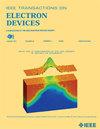Significant Enhancement of Light Extraction in AlGaN-Based Deep-UV LED Through Ag-Nanodot/Ti/Al Reflective p-Contacts With an Ultra-Thin Ti Barrier
IF 2.9
2区 工程技术
Q2 ENGINEERING, ELECTRICAL & ELECTRONIC
引用次数: 0
Abstract
AlGaN-based deep ultra-violet (DUV) LEDs, which emit in the 200–280 nm range, hold great promise for applications in water and air purification, sterilization, and medical diagnostics while light extraction efficiency (LEE) is a primary bottleneck for improving the overall efficiency of deep-ultraviolet light-emitting diodes (DUV LEDs). In this study, guided by finite-difference time-domain (FDTD) simulations, we designed and fabricated Ag-nanodot/Ti/Al reflective p-contacts with an ultra-thin Ti barrier for DUV LEDs. The results demonstrated a 36% increase in wall plug efficiency (WPE) while maintaining good ohmic contact when Ti thickness decreased from 100 to 5 nm. Scanning electron microscope (SEM) analysis revealed the robust stability of the contact structure. The WPE (@51.7 A/cm2, 40 mA) and LEE of the DUV LEDs with Ag-nanodot/Ti/Al p-contacts of 5-nm-thick Ti reached 4.42% and 9.575%, respectively. The results highlight the importance of p-contact reflectivity in achieving high-efficiency DUV LEDs and demonstrate a feasible route for improving the light output power (LOP) of DUV LEDs. This involves optimizing the reflector through metal-composite engineering, guided by FDTD simulations.ag -纳米点/Ti/Al反射p-触点与超薄Ti阻挡层对gan基深紫外LED光提取的显著增强
海藻基深紫外(DUV) led的发光波长在200 - 280nm范围内,在水和空气净化、灭菌和医疗诊断等领域有着巨大的应用前景,而光提取效率(LEE)是提高深紫外发光二极管(DUV led)整体效率的主要瓶颈。在有限差分时域(FDTD)模拟的指导下,我们设计并制造了用于DUV led的ag -纳米点/Ti/Al反射p触点,并带有超薄Ti阻挡层。结果表明,当Ti厚度从100 nm降至5 nm时,壁塞效率(WPE)提高了36%,同时保持了良好的欧姆接触。扫描电镜(SEM)分析显示了接触结构的鲁棒稳定性。采用5 nm厚Ti的Ag-nanodot/Ti/Al p-触点的DUV led的WPE (@51.7 A/cm2, 40 mA)和LEE分别达到4.42%和9.575%。研究结果强调了p接触反射率对实现高效DUV led的重要性,并为提高DUV led的光输出功率(LOP)提供了可行的途径。这包括在时域有限差分模拟的指导下,通过金属复合工程优化反射器。
本文章由计算机程序翻译,如有差异,请以英文原文为准。
求助全文
约1分钟内获得全文
求助全文
来源期刊

IEEE Transactions on Electron Devices
工程技术-工程:电子与电气
CiteScore
5.80
自引率
16.10%
发文量
937
审稿时长
3.8 months
期刊介绍:
IEEE Transactions on Electron Devices publishes original and significant contributions relating to the theory, modeling, design, performance and reliability of electron and ion integrated circuit devices and interconnects, involving insulators, metals, organic materials, micro-plasmas, semiconductors, quantum-effect structures, vacuum devices, and emerging materials with applications in bioelectronics, biomedical electronics, computation, communications, displays, microelectromechanics, imaging, micro-actuators, nanoelectronics, optoelectronics, photovoltaics, power ICs and micro-sensors. Tutorial and review papers on these subjects are also published and occasional special issues appear to present a collection of papers which treat particular areas in more depth and breadth.
 求助内容:
求助内容: 应助结果提醒方式:
应助结果提醒方式:


